Introduction to Baboons!
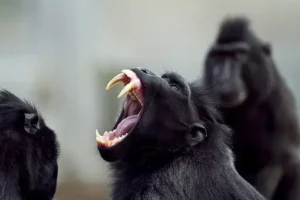
Baboons, members of the Papio genus, are a remarkable group of Old World monkeys that belong to the family Cercopithecoidea. With their distinctive physical features and complex social behaviors, they have captured the curiosity of scientists, wildlife enthusiasts, and adventurers alike. These fascinating primates are primarily found in Africa and are known for their adaptability, versatility, and unique adaptations that allow them to thrive in diverse environments.
Physical Characteristics:
They are known for their robust build and distinctive appearance. They are characterized by their dog-like snouts, which are hairless and often brightly colored, adding to their distinctive facial expressions. Their fur varies in color, ranging from olive green to brown or grey, depending on the species and location. Adult baboons typically measure between 20 to 30 inches in length, with their tails extending an additional 16 to 30 inches. One of the most recognizable features of baboons is their long, downward-curving tails.
Species and Distribution:
There are five primary species of baboons, the chacma baboon, olive baboon, yellow baboon, Guinea baboon, and hamadryas baboon. Each species has its own unique geographic distribution, ranging from the rainforests of West Africa to the arid savannas of the eastern African rift valley. These adaptations reflect their remarkable ability to adapt to a wide range of environments, from lush forests to arid deserts.
Social Behavior:
They are highly social creatures, forming complex hierarchies within their troops. Troops can consist of anywhere from a few individuals to several dozen, and they are usually led by a dominant male known as an “alpha” male. These social structures help baboons forage for food, protect against predators, and ensure the survival of their offspring.
Diet:
They are opportunistic omnivores, meaning they eat a wide variety of foods. Their diet includes fruits, leaves, seeds, insects, small mammals, and occasionally even larger prey.
Baboon Species and Classification:

They belong to the genus Papio, which is part of the family Cercopithecoidea, commonly known as the Old World monkeys. This family includes a wide range of primates found in Africa and parts of Asia. Within the genus Papio, there are five recognized species of their:
1. Olive Baboon (Papio Anubis): The olive baboon is one of the most widespread and well-known baboon species. It gets its name from its olive-green fur, which can vary in shade. They inhabit a range of environments, from savannas to forests, and are known for their complex social structures.
2. Yellow Baboon (Papio cynocephalus): Yellow baboons are recognized by their yellowish-brown fur and a pronounced cape of hair on their back. They are primarily found in East Africa and are known for their adaptability to various habitats.
3. Chacma Baboon (Papio ursin’s): The chacma baboon is the largest of the baboon species and is characterized by its dark brown to gray fur. They inhabit the southern regions of Africa, including South Africa, and are known for their impressive size and powerful jaws.
4. Hamadryas Baboon (Papio hamadryas): Hamadryas baboons have a distinctive appearance with a silvery-gray mantle of hair on their shoulders. They are native to the Horn of Africa and parts of the Arabian Peninsula. Unlike other baboons, they have a more hierarchical social structure.
5. Guinea Baboon (Papio Papio): Guinea baboons are primarily found in West Africa, and they have a reddish-brown coat. They often inhabit wooded savannas and are known for their foraging behavior.
They are renowned for their adaptability to various environments, from grasslands and savannas to forests and rocky terrains. They are highly social animals, forming complex hierarchies within their troops. Baboon troops can vary in size, ranging from a few individuals to over a hundred, depending on the species and the availability of resources in their habitat.
Within these troops, they engage in grooming, vocalizations, and various social interactions that help maintain group cohesion and structure. They are also known for their distinctive calls, which play a crucial role in communication within the troop.
Understanding the different species and classifications of baboons is essential for both researchers and conservationists, as it helps in the development of targeted conservation strategies and the preservation of these fascinating Old World monkeys in their natural habitats.
Physical Characteristics of Baboons:

They are highly adaptable primates known for their distinctive physical characteristics, which enable them to thrive in a variety of environments across Africa and the Arabian Peninsula. These charismatic animals exhibit several key features that set them apart from other primates:
1. Size and Build: They are robust and sturdy creatures, with males typically larger than females. On average, they measure between 20 to 34 inches (50 to 86 cm) in length, excluding their tails, which can add another 16 to 30 inches (40 to 76 cm) to their overall length. Males can weigh between 45 to 90 pounds (20 to 40 kilograms), while females are generally smaller, weighing around 30 to 60 pounds (14 to 27 kilograms).
2. Fur and Coloration: They have coarse fur that covers their bodies, which can vary in color from olive-green to brown, depending on the species and region. Typically, their faces and buttocks exhibit vivid colors like red, pink, or purple. These colorful patches serve as visual signals and are often associated with sexual attractiveness and social status.
3. Muzzle and Nose: One of the most recognizable features of baboons is their elongated, dog-like snouts, which house a formidable set of sharp canine teeth. This muzzle gives them a distinct appearance and serves as a tool for foraging and defense.
4. Tail: They have long tails that are often carried in an upward curve. These tails are not prehensile but serve various functions, including balance and communication. They also act as a visual signal for group cohesion.
5. Hands and Feet: They possess five fingers and toes on each limb, including opposable thumbs, which allow for a precision grip. They are terrestrial primates, and their hands and feet are adapted for both ground walking and climbing.
6. Sexual Dimorphism: As mentioned earlier, males are generally larger than females, and they also have larger canine teeth. This sexual dimorphism is primarily related to male-male competition and the defense of social hierarchies within the group.
7. Facial Features: They have expressive faces with forward-facing eyes that provide binocular vision. This allows them to accurately judge distances and navigate their complex environments.
Habitat and Distribution:
Baboons, known for their distinct appearance and complex social behaviors, are a group of Old World monkeys found across various regions of Africa and, in some cases, the Arabian Peninsula. These adaptable primates have managed to thrive in diverse habitats, from savannas and grasslands to woodlands and cliffsides.
Geographic Distribution:
Baboons are primarily indigenous to sub-Saharan Africa, where they inhabit a wide range of countries. Their distribution spans from the southern tip of the continent in South Africa to the Sahel region in the north and from the western coasts of Senegal and Guinea to the eastern borders of Ethiopia and Somalia. While their presence is more concentrated in eastern and southern Africa, they can be found in a variety of landscapes throughout the continent.
Habitat Variety:
One of the remarkable features of baboons is their adaptability to different environments. They are highly versatile in terms of habitat, allowing them to occupy a variety of ecosystems. Some of the common habitats where baboons are encountered include:
1. Savannas and Grasslands: Baboons are frequently found in open savannas and grasslands. These areas offer them a mix of resources, including grasses, fruits, and insects.
2. Woodlands: Baboons also inhabit wooded areas, where they can seek refuge from the sun and find fruits, leaves, and small animals to eat.
3. Riparian Zones: Many baboon species prefer habitats near water sources such as rivers and streams. These areas provide essential drinking water and attract a variety of food sources.
4. Cliffs and Rock Outcrops: Some baboon species, like the chacma baboon, are known for their ability to navigate steep cliffs and rocky terrain. These environments offer protection from predators and access to cliffside vegetation.
Grouping and Range:
Baboons are highly social animals, and their distribution often corresponds to the availability of resources and safety. They live in troops, which can vary in size but typically consist of several individuals, including males, females, and their offspring. Troops may range over a specific territory, which they defend against rival groups. The size of the territory and the troop’s range depend on factors such as food availability and the presence of competitors.
Angelfish: 10 Most Important Points About
Baboon Behavior and Social Structure:
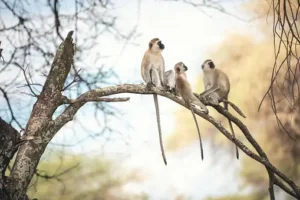
Baboons, a highly social and intelligent species of Old World monkeys, exhibit intricate behaviors and live within complex social structures. These primates are known for their adaptability and resilience, thriving in various habitats across Africa and the Arabian Peninsula. Understanding their behavior and social organization sheds light on their remarkable ability to survive in diverse environments.
Social Structure:
Baboons typically form multi-level societies, which can vary among different species and regions. The most common and widely studied species include the Olive baboon, Chacma baboon, and Guinea baboon. A baboon troop consists of several individuals, ranging from a few to over a hundred members, organized into a hierarchical structure.
At the core of the social hierarchy are dominant individuals, usually adult males, who hold the highest status within the troop. Dominance is often established through aggressive interactions, and dominant males enjoy priority access to food, mating opportunities, and grooming.
Females play crucial roles within baboon troops as well. They are typically organized into matrilineal families, forming bonds with other females and sharing parenting responsibilities. Female baboons often exhibit cooperative behaviors, such as grooming each other and assisting in childcare.
Communication:
Communication is essential for maintaining social cohesion within baboon troops. These primates employ a wide range of vocalizations, facial expressions, and body postures to convey information and establish social bonds. Baboons use vocalizations like barks, grunts, and screams to signal danger, express dominance, or coordinate group activities.
Behaviors:
Baboons are known for their diverse behavioral repertoire. They spend their days foraging for a variety of foods, such as fruits, leaves, insects, and small mammals. They are opportunistic feeders and adapt their diet to seasonal changes and food availability.
Baboons also engage in grooming, which serves not only to maintain hygiene but also to reinforce social bonds and reduce tension within the group. Playful interactions among juvenile baboons are common and help them develop important social skills.
Conflict Resolution:
While baboon troops exhibit a strict social hierarchy, conflicts are inevitable. Baboons have developed several mechanisms for conflict resolution, including reconciliation through grooming and appeasement behaviors. These strategies help reduce tension and maintain group cohesion.
Baboon Diet and Feeding Habits:

Baboons, highly adaptable and opportunistic omnivores, exhibit a diverse diet influenced by their habitat and availability of food resources. Their feeding habits play a crucial role in their daily lives and social dynamics.
1. Plant-Based Diet: Baboons are primarily herbivorous, with plants making up the bulk of their diet. They consume a wide array of vegetation, including leaves, stems, flowers, fruits, and roots. Depending on the season and location, their preferences may shift. During the dry season when green vegetation is scarce, they often rely on woody plants, roots, and bulbs, which provide essential nutrients.
2. Opportunistic Feeders: Baboons are opportunistic in their feeding habits. They are known to switch between food sources based on availability. For instance, they may feast on fruits when they are in season and readily accessible, but quickly transition to leaves and other plant materials when fruits become scarce.
3. Insectivorous Behavior: In addition to plants, baboons also incorporate insects and small invertebrates into their diet. They actively forage for insects like ants, termites, and grubs, using their nimble fingers to search through crevices and termite mounds. This behavior helps supplement their protein intake, especially during the breeding season or when plant-based food sources are limited.
4. Scavenging and Human Interaction: Baboons are known scavengers, and they often raid crops and human settlements, leading to conflicts with farmers. Their adaptability to human-altered environments has allowed them to exploit human food sources, such as crops, garbage, and discarded food items.
5. Water Requirement: Baboons are dependent on water sources, and they need to drink regularly. They are usually found near rivers, streams, or water holes, where they can quench their thirst and access aquatic vegetation.
6. Social Aspects of Feeding: Baboons are social animals, and their feeding habits are intricately linked with their social hierarchy. Dominant individuals often have priority access to the best food resources, while subordinates may have to make do with what’s left. This can lead to complex social dynamics within the troop.
Reproduction and Family Life:
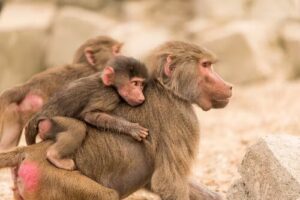
Baboons, known for their complex social structures and intricate behaviors, also exhibit fascinating reproductive and family dynamics. These primates are highly social creatures, and their reproductive strategies play a crucial role in maintaining the cohesion of their troops.
Mating and Reproduction: Baboons are polygamous animals, meaning that they have multiple mates. Mating within a troop is not limited to a specific breeding season; it can occur throughout the year. Dominant males in the troop have the privilege of mating with multiple females, while subordinate males may have limited or no mating opportunities.
Gestation and Birth: The gestation period for baboons is approximately six months. Typically, females give birth to a single offspring, although twins can occur occasionally. Mothers are the primary caregivers for their young, nursing them and providing protection.
Family Units: Baboon troops are organized into matrilineal family units. These units are typically led by an alpha male and include several adult females and their offspring. The alpha male plays a critical role in protecting the group from potential threats. The females within the unit often form strong bonds, and cooperative parenting is common, with multiple individuals helping care for and protect the young baboons.
Weaning and Independence: Infant baboons are weaned at around six months, but they remain dependent on their mothers and the troop for several years. As they grow, young baboons start to become more independent and learn essential survival skills by observing and interacting with other troop members.
Role of the Troop: The troop serves as a crucial support system for baboon families. Baboons rely on their fellow troop members for protection, foraging, and social interactions. The troop’s collective knowledge and resources are essential for the survival and well-being of the individuals within it.
Predators and Threats to Baboons:
Baboons, known for their agility, intelligence, and complex social structures, are not without their share of predators and threats in the wild. While they have evolved to become formidable creatures themselves, they face various challenges in their natural habitats.
Natural Predators: The primary natural predators of baboons are large carnivores such as lions, leopards, and hyenas. These apex predators occasionally target baboons, especially when they are vulnerable, such as during the night or when they are feeding on the ground.
Human Activity: Baboons often come into contact with human populations due to habitat encroachment and urbanization. As a result, they are subjected to threats from humans, including habitat destruction, hunting, and poaching. In some regions, baboons are hunted for their meat, fur, or body parts believed to have medicinal value.
Conflict with Farmers: Baboons are known to raid agricultural crops, leading to conflicts with farmers. In retaliation, farmers may kill or capture baboons to protect their livelihoods. This human-wildlife conflict can be detrimental to baboon populations.
Disease: Like many wildlife species, baboons are susceptible to diseases that can decimate populations. Outbreaks of diseases, such as tuberculosis and simian immunodeficiency virus (SIV), can spread within baboon groups and have devastating consequences.
Climate Change: Climate change impacts can affect baboons indirectly by altering their habitats and food sources. Changes in temperature and precipitation patterns can lead to reduced availability of food and water, making survival more challenging.
Conservation efforts are crucial to mitigate these threats. Protecting baboon habitats, implementing sustainable farming practices that reduce human-baboon conflicts, and monitoring and controlling disease outbreaks are essential steps in safeguarding these remarkable primates. Additionally, educating local communities about the importance of baboon conservation can help foster coexistence and support long-term survival efforts for these captivating creatures.
Conservation Status of Baboons:
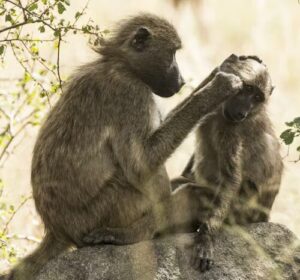
The conservation status of baboons varies among different species and regions. Baboons are primarily found in Africa and the Arabian Peninsula, and their status is influenced by a combination of factors including habitat loss, human-wildlife conflict, and poaching.
Vulnerable Species: Some baboon species, such as the Guinea baboon (Papio Papio), are considered relatively stable in terms of population numbers and are classified as “Least Concern” by the International Union for Conservation of Nature (IUCN). However, others are more vulnerable. The Chacma baboon (Papio ursin’s), for instance, is classified as “Least Concern” overall, but certain populations are at risk due to habitat fragmentation and human activities.
Habitat Loss: One of the primary threats to baboon populations is habitat loss. As human populations expand and agriculture, infrastructure development, and urbanization increase, baboons often lose their natural habitats. This forces them into closer proximity to human settlements, leading to conflicts and sometimes lethal consequences for both baboons and humans.
Human-Wildlife Conflict: Baboons can be considered agricultural pests in some areas, raiding crops and causing economic losses for local farmers. This often results in retaliatory killings, further endangering baboon populations.
Poaching: While not a major threat for all baboon species, some are hunted for their meat, fur, or body parts, especially in parts of Africa.
To ensure the conservation of baboons, it is crucial to implement measures that protect their natural habitats, mitigate human-wildlife conflicts, and enforce laws against poaching. Additionally, public awareness and community-based conservation efforts can play a vital role in safeguarding these remarkable primates. Conservation organizations, researchers, and governments must work together to secure a future for baboons in the wild and maintain the delicate balance between humans and these charismatic animals.
Cultural and Historical Significance:
Baboons have held a unique place in human history and culture for centuries. Their presence has left an indelible mark on various societies, folklore, and religious beliefs. Here, we delve into the cultural and historical significance of these intriguing primates.
Religious Symbolism: In many ancient cultures, baboons were associated with deities and revered for their intelligence. In ancient Egypt, the god Thoth was often depicted with the head of a baboon, symbolizing wisdom and writing. Baboons were also linked to the sun god Ra.
Folklore and Mythology: Baboons have appeared in numerous myths and stories across Africa and beyond. In some African folklore, they are portrayed as cunning tricksters, often outsmarting humans. Their behavior, such as grooming and social hierarchies, has influenced stories that reflect human society.
Art and Symbolism: Baboons frequently feature in art, from ancient cave paintings to modern sculptures. Their striking appearance, expressive faces, and social dynamics have inspired artists to create various representations of these animals.
Medicine and Healing: In some traditional African medicinal practices, baboon parts were believed to possess healing properties. However, this has raised ethical concerns, leading to conservation efforts to protect these animals.
Scientific Interest: Baboons have been subjects of scientific research, contributing to our understanding of primate behavior, social structures, and evolution. Their study has implications not only for anthropology but also for psychology and biology.
Top 10 Best Guard Dog Breeds to Protect Your House and Family
Research and Study of Baboons:
Baboons, a diverse group of Old World monkeys, have been the subject of extensive research and study by scientists and primatologists for many decades. This research has contributed significantly to our understanding of primate behavior, evolution, and ecological dynamics. Here, we delve into the key aspects of baboon research.
Behavioral Studies: Baboons are renowned for their complex social structures and behaviors. Researchers have spent countless hours observing and documenting their interactions within troops. These studies have revealed hierarchies, communication patterns, and cooperation among baboons, shedding light on primate social evolution and even offering insights into human social dynamics.
Ecological Research: Baboons inhabit a wide range of ecosystems across Africa, from savannas to forests. Ecologists have studied their impact on these environments, including their foraging habits and role as seed dispersers. Such studies help us understand the ecological roles baboons play in maintaining the health of their habitats.
Genetic Studies: Genetic research on baboons has enabled scientists to trace their evolutionary history and genetic diversity. DNA analysis has provided insights into their relationships with other primates, including humans, and has deepened our understanding of their evolutionary adaptations.
Health and Disease: Baboons are valuable models for studying various aspects of primate health and disease. Researchers have investigated topics such as infectious diseases, reproductive physiology, and stress responses. Findings from these studies have practical applications in both human and veterinary medicine.
Conservation Efforts: Research on baboons also plays a critical role in their conservation. Understanding their behavior, habitat requirements, and population dynamics helps inform conservation strategies and policies aimed at protecting these primates and their ecosystems.
Interesting Facts about Baboons:
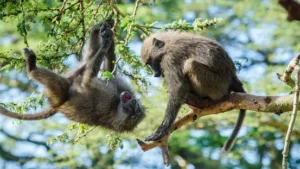
Baboons are fascinating creatures known for their complex social structures and unique behaviors.
1. Variety of Species: Baboons belong to the genus Papio and are a part of the Old World monkey family. There are five recognized species of baboons: olive, yellow, chacma, Guinea, and hamadryas baboons.
2. Social Hierarchy: Baboons live in large, tightly-knit social groups called troops, which can consist of up to 200 individuals. Within these troops, a strict social hierarchy exists, with dominant males leading the group.
3. Complex Communication: Baboons communicate through a combination of vocalizations, facial expressions, and body language. They use different calls to warn of predators, signal group movements, or express submission.
4. Omnivorous Diet: Baboons are omnivorous and eat a wide variety of foods, including fruits, leaves, insects, and small mammals. This adaptable diet helps them survive in various habitats.
5. Impressive Canine Teeth: Baboons have long, sharp canine teeth that they use for both defense and offense. These teeth are particularly prominent in males and can be intimidating.
6. Territorial Behavior: Troops of baboons establish and defend territories. They are known to engage in fierce conflicts with neighboring troops to protect their territory and resources.
7. Baboon Troop Dynamics: Baboon troops are matrilineal, meaning that females and their offspring form the core of the group. Males often join new troops as they mature or attempt to take over leadership.
8. Human Interaction: Baboons have a unique relationship with humans in some regions. They are known to raid farms and villages in search of food, which can lead to conflicts between humans and baboons.
9. Longevity: In the wild, baboons generally live to be around 20-30 years old, depending on the species and environmental conditions. In captivity, they can live even longer.
10. Cultural Significance: In some African cultures, baboons hold cultural and spiritual significance. They are featured in folklore, stories, and traditional rituals.
11. Research Subjects: Baboons have been the subjects of extensive research, particularly in the fields of primatology and behavioral ecology. Their complex social structures make them valuable for studying group dynamics and cooperation.
Baboons in Popular Culture:
Baboons have made their mark in popular culture through various forms of media and entertainment. These remarkable primates have been featured in movies, literature, and even video games, captivating audiences with their unique behaviors and striking appearance.
1. The Lion King: Perhaps one of the most iconic appearances of baboons in popular culture is Rafiki, the wise and mystical mandrill in Disney’s “The Lion King.” Rafiki serves as a spiritual guide and advisor to the main characters, Simba and Mufasa, adding depth to the storyline.
2. Tarzan: In the world of literature and film, baboons have been prominently featured in the story of Tarzan. The character Tarzan is often depicted as being raised by a tribe of African baboons, showcasing their complex social dynamics.
3. Planet of the Apes: While not baboons specifically, the “Planet of the Apes” franchise has brought various simian species, including baboons, into the spotlight. These films explore the consequences of advanced ape societies and their interactions with humans.
4. Video Games: Baboons have also found their way into video games like “Zoo Tycoon” and “Planet Zoo,” where players can create and manage their own virtual zoos, including baboon exhibits.
5. Advertising and Branding: Baboons have been used in advertising and branding to convey a sense of energy, curiosity, and playfulness. Their expressive faces and distinct behaviors make them memorable symbols for various products and companies.
6. Documentary Films: Documentaries, such as “Baboon King” and “Baboons with Bill Bailey,” have shed light on the lives and behaviors of these fascinating primates, educating and entertaining viewers about their natural history.
7. Cartoons and Animation: Baboons have appeared in numerous animated series and cartoons, often as comedic characters, showcasing their animated personalities and quirks.
Baboons’ presence in popular culture serves as a testament to their intrigue and charisma, captivating both children and adults alike. These representations contribute to a broader awareness of these remarkable animals and the need for their conservation in the wild.
Baboon Conservation Efforts:
Baboons, like many other wildlife species, face significant conservation challenges in the modern world. Human encroachment, habitat destruction, and the illegal pet trade are just a few of the threats these charismatic primates encounter. However, concerted efforts are being made to protect and conserve baboon populations.
Protected Areas: Establishing and maintaining protected areas and wildlife reserves is crucial for baboon conservation. These designated regions provide safe havens where baboons can live and thrive without direct human interference.
Research and Monitoring: Scientists and conservationists closely monitor baboon populations to better understand their behavior, genetics, and health. This research helps inform conservation strategies and track the effectiveness of these efforts.
Community Education: Raising awareness and educating local communities about the importance of baboons in their ecosystems is vital. By fostering a sense of stewardship, people are more likely to support conservation initiatives.
Anti-Poaching Measures: Baboons are often targeted by poachers for the pet trade or body parts. Anti-poaching efforts, including law enforcement and wildlife trafficking prevention, are essential for their protection.
Habitat Restoration: Baboon habitats are under constant threat from urbanization and agriculture. Habitat restoration projects aim to rehabilitate and reconnect fragmented landscapes.
Human-Wildlife Conflict Mitigation: Implementing strategies to reduce conflicts between baboons and local communities, such as secure trash disposal and protective fencing, helps foster coexistence.
International Collaboration: Baboon conservation efforts often require collaboration between governments, NGOs, and international organizations to address cross-border issues.
With these conservation initiatives, there is hope that baboon populations can rebound and continue to play their vital roles in their ecosystems. It’s imperative that we work together to ensure the long-term survival of these remarkable primates.
Conclusion: The Fascinating World of Baboons
In conclusion, the world of baboons is truly fascinating and diverse, offering a captivating glimpse into the complexities of nature. These remarkable primates, found in various regions of Africa and the Arabian Peninsula, exhibit a wide range of behaviors, adaptations, and social structures that have intrigued scientists and enthusiasts alike.
Baboons are known for their distinctive physical features, with their long muzzles, robust bodies, and characteristic tails. However, their uniqueness extends beyond their appearance. They live in complex societies, characterized by hierarchical structures and intricate social bonds. These social structures help them thrive in challenging environments and protect against predators.
Their adaptability is further showcased through their diverse diet, which includes fruits, vegetation, insects, and even small mammals. This versatility has allowed baboon populations to persist across a wide range of habitats, from savannas to forests.
Despite their resilience, baboons face numerous threats, including habitat loss and human-wildlife conflict. Conservation efforts are crucial to ensure the survival of these incredible creatures, as they play an essential role in maintaining the ecological balance of their habitats.
As we continue to study and appreciate the world of baboons, we gain valuable insights into the intricacies of nature’s design. Their existence serves as a testament to the richness of biodiversity on our planet and the importance of preserving it for future generations to explore and marvel at. Baboons are not just fascinating creatures; they are a vital part of the tapestry of life on Earth, deserving of our attention, respect, and protection.
FAQ’s:
What is a Baboon?
A baboon is a type of Old World monkey belonging to the genus Papio. These primates are known for their distinctive appearance, which includes long muzzles, dog-like snouts, and large, sharp canine teeth. They are found in various parts of Africa and are known for their complex social structures and vocalizations.
What are the Different Species of Baboons?
There are five main species of baboons: Olive baboon, Yellow baboon, Chacma baboon, Hamadryas baboon, and Guinea baboon.
What Do Baboons Eat?
Baboons are omnivorous animals, which means they eat a wide variety of foods. Their diet includes fruits, leaves, seeds, insects, small mammals, and even birds. They are opportunistic feeders and adapt their diet based on what is available in their environment.
Are Baboons Dangerous to Humans?
While baboons are not typically aggressive towards humans, they can become a threat when provoked or if they feel their territory is being threatened. It’s essential to observe baboons from a safe distance in the wild and avoid feeding them, as this can lead to habituation and potentially dangerous interactions.
What is the Significance of Baboons in African Culture?
Baboons hold cultural significance in various African societies. In some cultures, they are seen as symbols of wisdom and adaptability. They have also appeared in folklore and mythology as trickster figures or characters with both positive and negative attributes, reflecting the complex relationship between humans and these primates in African history.


